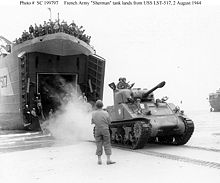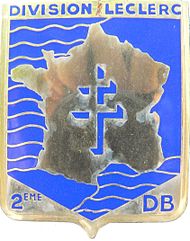- Free French Forces
-
Forces Françaises Libres 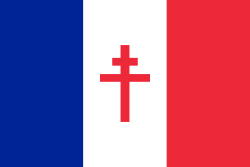
Active 18 June 1940–8 May 1945 Country France Size 550,000 (1944)
1,300,000 (1945)Engagements World War 2 - Occupation of France
- North African Campaign
- Italian Campaign
- Invasion of Normandy
Commanders Notable
commandersCharles de Gaulle 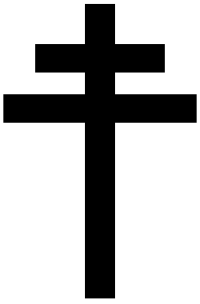 The Cross of Lorraine, chosen by General Charles de Gaulle as the symbol of the Free French Forces.[1]
The Cross of Lorraine, chosen by General Charles de Gaulle as the symbol of the Free French Forces.[1]
The Free French Forces (French: Forces Françaises Libres, FFL) were French partisans in World War II who decided to continue fighting against the forces of the Axis powers after the surrender of France and subsequent German occupation and, in the case of Vichy France, collaboration with the germans.
Contents
Definition
In many sources, Free French describes any French individual or unit that fought against Axis forces after the June 1940 armistice. The reality is more complex as the French forces of the Army of Africa under General Henri Giraud did take part in the fight against the Axis, for example in Tunisia in early 1943, without any relationship with Charles de Gaulle's organization.
Historically, an individual became Free French after he enlisted in de Gaulle's Free French organisation located in London. Free French units were units formed by these people. De Gaulle's organization stopped accepting members in mid-1943 as Free French forces were merging with the French forces in North Africa, and the Comité français de libération nationale (CFLN) was set up in Algiers.
Postwar, to settle disputes over the Free French heritage, the French government issued an official definition of the term. Under this "ministerial instruction of July 1953" (instruction ministérielle du 29 juillet 1953), only those who served with the Allies after the Franco-German armistice in 1940 and before 1 August 1943 may correctly be called "Free French".[2]
French forces after July 1943 are therefore correctly designated as the "forces of Liberation".
This article also includes the activities of French forces after 1942, in order to maintain continuity.
History
Prelude
In 1940, General Charles de Gaulle was a member of the French cabinet during the Battle of France. As French defence forces were increasingly overwhelmed, de Gaulle found himself part of a small group of politicians who argued against a negotiated surrender to Nazi Germany and Fascist Italy. As these views were shared by the President of the Council, Paul Reynaud, de Gaulle was sent as an emissary to Britain; it was during this time that the French government collapsed.
On 16 June, the new French President of the Council, Philippe Pétain, began negotiations with Axis officials. On 18 June, de Gaulle spoke to the French people via BBC radio. He asked French soldiers, sailors and airmen to join in the fight against the Nazis. In France, de Gaulle's "Appeal of the 18th of June" (Appel du 18 juin) was not widely heard that day but, together with de Gaulle's BBC broadcasts[3] in subsequent days and his later communications, came to be widely remembered throughout France and its colonial empire as the voice of national honour and freedom. Some of the British Cabinet had attempted to block the speech, but were overruled by British Prime Minister Winston Churchill. To this day, the Appeal of 18 June remains one of the most famous speeches in French history. Nevertheless, on 22 June, Pétain signed the armistice followed by a similar one with Italy on June 24; both of these came into force on 25 June.[4] After parliamentary vote 10 July, Pétain became leader of the newly established authoritarian regime known as Vichy France, the town of Vichy being the seat of government.
De Gaulle was tried in absentia in Vichy France and sentenced to death for treason; he, on the other hand, regarded himself as the last remaining member of the legitimate Reynaud government able to exercise power, seeing the rise to power of Pétain as an unconstitutional coup.
Composition
See also: French West Africa and French colonial empireThe Free French forces were drawn mostly from the French colonial empire, rather than from metropolitan France. French nationals from the tropical African colonies formed a large part of the forces at the beginning, as were nationals from French Algeria. Later, many combatants were drawn from the native populations of French colonies. Sixty-five percent were conscripts from French West Africa, primarily Senegal[citation needed]. Other contingents were natives of Morocco, Algeria, and Tahiti (the Tahitians served with particular distinction in the western Sahara). The Free French forces also included units of the Foreign Legion.
Out of about 60,000 troops evacuated from France in July 1940, only about 3,000 chose to continue the struggle, joining de Gaulle's army in London.[5] By the end of the year, he had 7,000 troops.[6]
In 1944, once the Allies had defeated the German army in Normandy, Free French leaders wanted their troops to lead the liberation of Paris. Allied High Command requested the Free French force in question to be all-white, if possible, but this was very difficult because of the large numbers of black West Africans in their ranks. The 2nd Armored Division was chosen because only about one quarter of its troops were black.[7]
During the winter of 1944 and 1945, many of the African troops in the Free French forces were replaced with whites. This process of blanchiment (whitening) was undertaken for several discriminatory, and a few non-discriminatory reasons. First, the full manpower of metropolitan France was available for the first time since 1940. Second, the original African recruits had suffered heavy casualties, or they had become worn-down by years of fighting, and conscripting or recruiting more was not practical. Third, African troops tended to become ill during the European winter's extreme weather. Fourth, it was politically vital to get all elements of French society involved in the war, including former Vichyites, many of whom had adopted racist attitudes toward Jews, etc., and could be similarly expected to have negative feelings toward the blacks. Finally, the Free French leadership did not want France to be perceived as dependent for its victory on non-white colonial subjects.
The Free French units in the Royal Air Force, Soviet Air Force, and British SAS were mainly composed of men from metropolitan France.
Cross of Lorraine
Capitaine de corvette Thierry d'Argenlieu[8] suggested the adoption of the Cross of Lorraine as a symbol of the Free French, both to recall the perseverance of Joan of Arc, whose symbol it had been, and as an answer to the Nazi swastika.[9] In his general order № 2 of 3 July 1940, Vice Admiral Émile Muselier, two days after assuming the post of chief of the naval and air forces of the Free French, created the bow flag displaying the French colors with a red cross of Lorraine, and a cockade, which also featured the cross of Lorraine.
Following repeated broadcasts, by the end of July 1940, seven thousand people had volunteered for the Free French forces. The Free French Navy manned some 50 ships with about 3,700 men operating as an auxiliary force to the British Royal Navy.
A monument on Lyle Hill in Greenock, in western Scotland, in the shape of the Cross of Lorraine combined with an anchor, was raised by subscription as a memorial to the Free French naval vessels that sailed from the Firth of Clyde to take part in the Battle of the Atlantic. The memorial is also associated, locally, with the memory of the French destroyer Maillé Brézé (1933) which sank at the Tail of the Bank.
-
The French flag with the Cross of Lorraine, emblem of the Free French.
-
Free French Forces Adrian helmet with the Cross of Lorraine replacing the 1939-1940 French Republic "RF" emblem.
Mers El Kébir
British Prime Minister Winston Churchill feared that, in German or Italian hands, the ships of the French Navy could be a grave threat to the Allies. He insisted that French warships either join the Allies or be put out of use in a British, French, or neutral port. As a last resort, Churchill ordered that French warships were to be destroyed by British attack.
On 3 July 1940, British warships attacked French ships at Mers El Kébir in Algeria, sinking or crippling three battleships. This attack caused bitterness in France, particularly in the Navy (over 1,000 French sailors were killed), and discouraged many French soldiers from joining the Free French forces.
Some French warships did remain on the Allied side and others re-joined later after the Axis occupation of Vichy France (codenamed Case Anton) and the scuttling of the French fleet in Toulon. Those ships flew a separate flag, the Free French Naval Ensign, which is still in use as a mark of honour by ships that continue to use the name of a Free French ship.
The struggle for control of French colonies
 The fall of Damascus to the Allies, late June 1941. A car carrying Free French commanders General Georges Catroux and General Paul Louis Le Gentilhomme enters the city, escorted by French Circassian cavalry (Gardes Tcherkess).
The fall of Damascus to the Allies, late June 1941. A car carrying Free French commanders General Georges Catroux and General Paul Louis Le Gentilhomme enters the city, escorted by French Circassian cavalry (Gardes Tcherkess).
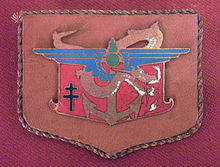 Insigna of the Free French Forces in the Far East (French Indochina), Langlade Mission.
Insigna of the Free French Forces in the Far East (French Indochina), Langlade Mission.
After the fall of France in 1940, the French colonies of Cameroun and French Equatorial Africa (except for Gabon) joined the Free French while the remainder sided with the Vichy Regime. With the addition of French African colonies came a large number of African colonial troops. From July-November 1940, Free French forces fought French troops loyal to Vichy France during the West African Campaign. The outcome of this campaign was mixed with the Vichy French claiming victory at the Battle of Dakar and the Free French claiming victory at the Battle of Gabon. The French West African colonies remained Vichy French and the French Equatorial African colonies, now including Gabon, remained Free French.
In Asia and the Pacific, the French South Pacific colonies of New Caledonia, French Polynesia and the New Hebrides joined the Free French later. The South Pacific colonies would become vital Allied bases in the Pacific Ocean. French Indochina was invaded by Japan in September 1940, although the colony remained under nominal Vichy control. On 9 March 1945, the Japanese took full control of Indochina and launched the Second French Indochina Campaign.
In North America, Saint-Pierre and Miquelon (near Canada) joined the Free French after an "invasion" on 24 December 1941 by Rear Admiral Emile Muselier and the forces he was able to load onto three corvettes and a submarine of the Free French Naval Forces (Forces navales françaises libres, or FNFL).
During 1941, Free French units fought with the British Commonwealth army against Italian troops in Ethiopia and Eritrea during the East African Campaign. During the Syria-Lebanon Campaign, Free French forces fighting alongside British Commonwealth forces once more faced French troops loyal to Vichy France — this time in the Levant. By July 1941, General Henri Dentz and his Vichy Army of the Levant were defeated. Free French General Georges Catroux was appointed High Commissioner of the Levant. From this point, Free France controlled both Syria and Lebanon until they became independent.
 15,000 Chadian soldiers fought for Free France during WWII.[10]
15,000 Chadian soldiers fought for Free France during WWII.[10]
In Africa, the Vichy colonies were gradually overthrown as Free French forces took part in the allied campaigns on the continent. Free French soldiers participated in the Allied North African campaign, in Libya and Egypt. General Marie Pierre Koenig and his unit—the 1st Free French Brigade—fought well against the Afrika Korps at the Battle of Bir Hakeim in June 1942, although eventually obliged to withdraw. To the west, the Allies launched Operation Torch, an invasion of Vichy-controlled French North Africa in November 1942. Many Vichy troops surrendered and joined the Free French cause. Vichy coastal defences were captured by the French Resistance. Vichy General Henri Giraud rejoined the Allies, but he lacked the authority that was required and de Gaulle kept his leadership of the Free French, despite American objections. In late 1942, after the Battle of Madagascar, the Vichy French forces—under Governor-General Armand Léon Annet—were defeated and Free French General Paul Legentilhomme was appointed High Commissioner for Madagascar. On 28 December, after a prolonged blockade, the Vichy forces in French Somaliland were ousted.
The Nazi Germans lost faith in the Vichy regime after Operation Torch, and—during Case Anton in November 1942—German and Italian forces occupied Vichy France. In response, the 60,000-strong Vichy forces in French North Africa—the Army of Africa—joined the Allied side as the French XIX Corps within the British 1st Army, which also included the U.S. II Corps and two British corps. They fought in Tunisia for six months until April 1943. Using antiquated equipment, the XIX Corps took heavy casualties (16,000) against modern armor and a desperate Axis enemy.
After these successes, Guadeloupe and Martinique in the West Indies—as well as French Guiana on the northern coast of South America—joined Free France in 1943. In November 1943, the French forces received enough military equipment through Lend-Lease to re-equip eight divisions and allow the return of borrowed British equipment. At this point, the Free French and ex-Vichy French Corps were merged. In 1943, Colonel (later General) Philippe Leclerc and Lieutenant-Colonel Camille d'Ornano led a column of 16,500 colonial troops from Chad to attack Italian forces in southern Libya and to occupy Kufra in the Fezzan region.
The Air War
Main article: Free French Air ForceThere were sufficient Free French pilots to man several squadrons based in Britain and North Africa, mainly from African colonial bases but also volunteers from South American countries such as Uruguay, Argentina and Chile. They were initially equipped with a mixture of British, French and American aircraft. They had mixed success at first, and French army-air cooperation was often poor.
At de Gaulle's initiative, the Groupe de Chasse 3 Normandie was formed on 1 September 1942, for service on the Eastern Front. It served with distinction and was awarded the supplementary title Niemen by Stalin.
The War at Sea
Main article: Free French Naval ForcesThe Free French Navy—commanded by Admiral Emile Muselier—played a role in the occupation of French colonies in Africa, in supporting the French Resistance, in D-Day (Operation Neptune), and the Pacific War.
The Forces Françaises Combattantes and National Council of the Resistance
The French Resistance gradually grew in strength. General de Gaulle set a plan to bring together the different groups under his leadership. He changed the name of his movement to "Fighting French Forces" (Forces Françaises Combattantes) and sent Jean Moulin back to France to unite the eight major French Resistance groups into one organisation. Moulin got their agreement to form the "National Council of the Resistance" (Conseil National de la Résistance). Moulin was eventually captured, and died under brutal torture by the Gestapo.
Later, the Resistance was more formally referred to as the "French Forces of the Interior" (Forces Françaises de l'Intérieur, or FFI). From October 1944-March 1945, many FFI units were amalgamated into the French Army in order to regularize the units.
Liberation of France
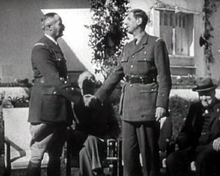 FFF leaders General Henri Giraud and General Charles de Gaulle in front of Roosevelt and Churchill at the Casablanca Conference, 14 January 1943.
FFF leaders General Henri Giraud and General Charles de Gaulle in front of Roosevelt and Churchill at the Casablanca Conference, 14 January 1943.
In September 1943, the liberation of Corsica began with the landing of elements of the reconstituted French I Corps (Operation Vésuve). During the Italian Campaign of 1943-1944, 130,000 Free French soldiers fought on the Allied side, notably in the fighting on the Winter Line and Gustav Line.[citation needed] Another source gives the number of 70,000.[6]
By the time of the Normandy Invasion, the Free French forces numbered more than 400,000 strong.[citation needed] 900 Free French paratroopers landed as part of the in the British Special Air Service (SAS) Brigade; the Free French 2nd Armored Division—under General Leclerc—landed at Utah Beach in Normandy on 1 August 1944, and eventually led the drive toward Paris, while the divisions which had been fighting in Italy became part of the French First Army—under General Jean de Lattre de Tassigny—and joined the U.S. 7th Army in Operation Dragoon. This operation was the Allied invasion of southern France. The Allied forces advanced up the line of the Rhône River to liberate the Vosges and southern Alsace.
 Leclerc's 2nd Armored Division parading down the Champs Elysées on 26 August 1944, the day after the Liberation of Paris.
Leclerc's 2nd Armored Division parading down the Champs Elysées on 26 August 1944, the day after the Liberation of Paris.
Fearing the Germans would destroy Paris if attacked by a frontal assault, General Dwight Eisenhower ordered his forces to cease their advance and reconnoitre the situation. At this time, Parisians rose up in full-scale revolt. As the Allied forces waited near Paris, General Eisenhower acceded to pressure from de Gaulle and his Free French Forces. De Gaulle was furious about the delay and was unwilling to allow the people of Paris to be slaughtered as had happened in the Polish capital of Warsaw during the Warsaw Uprising. De Gaulle ordered General Leclerc to attack single-handedly without the aid of Allied forces. In response, General Eisenhower—in an attempt to spare De Gaulle's forces heavy casualties during his initiative—granted the Free French forces the honour of spearheading the Allied assault and liberating the capital city of France.
General Leclerc sent a small advance party to enter Paris, with the message that the 2e Division Blindée (composed of 10,000 French, 3,600 Maghrebis [11][12] and about 350 Spaniards[13]) would be there the following day. This party was commanded by Captain Raymond Dronne, and was given the honor to be the first Allied unit to enter Paris ahead of the 2e Division Blindée. The 9th company of the 3rd Battalion of the Régiment de Marche du Tchad was made up mainly of Spanish Republican exiles. After hard fighting that cost the 2nd Division 35 tanks, six self-propelled guns, and 111 vehicles, von Choltitz, the military governor of Paris, surrendered the city at the Hôtel Maurice. Jubilant crowds greeted the Liberation of Paris. French forces and de Gaulle conducted a now iconic parade through the city.
End of the war
By September 1944, the Free French forces stood at 550,000 (including 195,000 French from North-Africa and 295,000 Maghrebis).[14] This number rose to 1 million by the end of the year. French forces were fighting in Alsace, the Alps, and Brittany. In May 1945, by the end of the war in Europe, the Free French forces comprised 1,300,000 personnel, and included seven infantry divisions and three armored divisions fighting in Germany making it the fourth allied army in Europe behind the Soviet Union, the U.S. and Britain. The French offered to send a division to the Pacific to help fight the Japanese toward the end of the war, but it ended before they could be sent.
At that time, General Alphonse Juin was the chief of staff of the French army, but it was General François Sevez who represented France at Reims on 7 May, while it was General Jean de Lattre de Tassigny who was the leader of the French delegation at Berlin on V-E day, as he was the commander of the French First Army. France was then given an occupation zone in Germany, as well as in Austria and in the city of Berlin, but they were given it slightly later than those of the "Big Three". It was not only the role that France played in the war which was recognized, but its important strategic position and significance in the Cold War as a major democratic, capitalist nation of Western Europe in holding back the influence of communism on the continent.
Units and commands on 8 May 1945
Armies
- French First Army
- Atlantic Army Detachment
- Alpine Army Detachment
Corps
- I Army Corps
- II Army Corps
- III Army Corps[15]
Divisions
- 1st Free French Division[16]
- 2nd Moroccan Infantry Division
- 3rd Algerian Infantry Division
- 4th Moroccan Mountain Division
- 9th Colonial Infantry Division
- 27th Alpine Infantry Division[17]
- 1st Armored Division
- 2nd Armored Division[16]
- 3rd Armored Division[15][17]
- 5th Armored Division
- 1st Infantry Division[15][17]
- 10th Infantry Division[17]
- 14th Infantry Division[17]
- 19th Infantry Division[17]
- 23rd Infantry Division[17]
- 25th Infantry Division[17]
- 36th Infantry Division[15]
- 1st Far East Colonial Division[15]
- 2nd Far East Colonial Division[15]
- 3rd and 4th Free French S.A.S. (Special Air Service) Battalions
Notable Free French
- Dimitri Amilakhvari
- Georges Thierry d'Argenlieu
- Josephine Baker
- Georges Bergé
- Georges Bidault
- Pierre Billotte
- Pierre Bourgoin
- Claude Hettier de Boislambert
- René Cassin
- Georges Catroux
- Pierre Clostermann
- Geoffroy Chodron de Courcel
- Ève Curie
- Suzanne David Hall
- André Dewavrin
- Félix Éboué
- René Iché
- Jean Gabin
- Charles de Gaulle
- Joseph Kessel
- Marie Pierre Koenig
- Edith de La Chevalerie
- Xavier de La Chevalerie
- André Laguerre
- Edgard de Larminat
- Pierre-Olivier Lapie
- Philippe Leclerc de Hauteclocque
- Paul Legentilhomme
- Pierre Marienne
- Anna Marly
- Pierre Mendès-France
- Pierre Messmer
- Jean Moulin
- Émile Muselier
- Gaston Palewski
- René Pleven
- Gabriel Brunet de Sairigné
- Maurice Schumann
- Jacques Soustelle
- Tereska Torres
- Susan Travers
- Martin Valin
- Raoul Magrin-Vernerey
- Simone Weil
- Raymonde Reimbert
- Pierre Bertaux
(More cited on French Resistance)
Notable French who joined after 1942
- Antoine Béthouart
- Jean René Champion
- Antoine de Saint-Exupéry
- Henri Giraud
- Alphonse Juin
- Marcel Marceau
- Jean Monnet
- Joseph de Goislard de Monsabert
- Jean de Lattre de Tassigny
- Jean Touzet du Vigier
See also
- French Forces of the Interior
- Maquis
- Normandie-Niemen Regiment : Free French air force fighting on the Eastern theatre of the Second World War.
- Goumiers
- Francs-Tireurs & Partisans
- Chant des Partisans
- Military history of France during World War II
- 1st South African Infantry Division
- Free China (Second Sino-Japanese War)
- List of French possessions and colonies
References
- ^ Pharand (2001), p. 169
- ^ La France Libre et les Français Libres : éléments de définition
- ^ de Gaulle, Charles (28 April 2007). "The flame of French resistance". The Guardian (London). http://www.guardian.co.uk/theguardian/2007/apr/29/greatspeeches1. Retrieved 27 March 2010.
- ^ P. M. H. Bell, France and Britain 1900-1940: Entente & Estrangement,London, New York, 1996, p 249'
- ^ Jean-Benoît Nadeau; Julie Barlow (2003). Sixty million Frenchmen can't be wrong: why we love France but not the French. Sourcebooks, Inc.. pp. 89–. ISBN 9781402200458. http://books.google.com/books?id=wtUWuzzYqa8C&pg=PA89. Retrieved 6 March 2011.
- ^ a b Pierre Goubert (20 November 1991). The Course of French History. Psychology Press. pp. 298–. ISBN 9780415066716. http://books.google.com/books?id=1VbZMbFw89YC&pg=PA298. Retrieved 6 March 2011.
- ^ "Paris liberation made 'whites only'". BBC News. 6 April 2009. http://news.bbc.co.uk/2/hi/europe/7984436.stm. Retrieved 27 March 2010.
- ^ www.france-libre.net, Le site de la France-Libre, "Les origines des FNFL, par l’amiral Thierry d’Argenlieu" (French)
- ^ The Cross of Lorraine from charles-de-gaulle.org at the Wayback Machine (archived November 26, 2005)
- ^ S. Decalo, 53
- ^ Olivier Forcade, Du capitaine de Hauteclocque au Général Leclerc, Vingtième Siècle, Revue d'histoire, Année 1998, Volume 58, Numéro 58, pp. 144-146
- ^ "Aspect méconnu de la composition de la 2e DB: en avril 1944, celle-ci comporte sur un effectif total de 14 490, une proportion de 25% de soldats nord-africains : 3 600", Christine Levisse-Touzé, Du capitaine de Hautecloque au général Leclerc?, Editions Complexe, 2000, p.243
- ^ Pierre Milza, Exils et migration: Italiens et Espagnols en France, 1938-1946, L'Harmattan, 1994, p. 590
- ^ Philippe Buton, La France et les Français de la Libération, 1944-1945: vers une France nouvelle?, Musée des deux guerres mondiales, Universités de Paris (University of Paris), 1984, p.95
- ^ a b c d e f Did not see combat during the Second World War
- ^ a b Free French origin
- ^ a b c d e f g h Formed with FFI personnel.
External links
- FFF fighting units (France-Libre.net)
- France-Libre.net (Free French Forces foundation)
- GIVUME III Regiment de marche du Tchad / 9eme compagnie
- Bibliographie about 1st Free French Division
- Fights of the population in Gers in the regular army from Nov.8, 1942 to Aug.31, 1944 (1992- O.N.A.C.- S.D. GERS translated in English)
- Flags and Ensigns of Free France
- France’s true greatest day
- Composition and situation of the Free French Force in combat
- WW2 from the French Point of view
- [1] Free French Black troops
Categories:- National liberation armies
- Free French Forces
- Charles de Gaulle
- France–United Kingdom relations
- Military history of France during World War II
- Governments in exile during World War II
Wikimedia Foundation. 2010.

